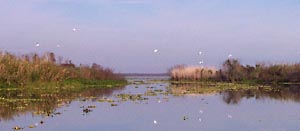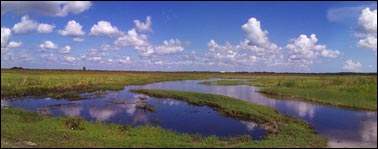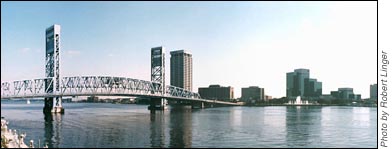 The river opening into the south end
of Lake Washington.
The river opening into the south end
of Lake Washington. |
RIVER TRIVIA:
The
St. Johns River is the largest river in Florida and runs 318 miles from
Melbourne to Jacksonville, cutting through some 14 counties. The source
of the river is the marshy area in the Indian River County (just south
of Brevard County where I live) and it flows into the ocean at Jacksonville.
There is less than a 30 foot drop of the river from it's source to its
mouth - about 1 inch per mile - making the St. Johns one of the "laziest"
rivers in the world.
The
St. Johns basin is an ancient intracoastal lagoon system. As sea levels
dropped, barrier islands became an obstacle that prevented water from
flowing east to the ocean. Instead, the water collected in the flat valley
and moved north. This formed the St. Johns. Many lakes originated as sinkholes,
but others such as Lake Washington and Lake George are natural depressions
on ancient sea floors. (Lake Washington is the water reservoir for the
city of Melbourne.)
 The marshes near the headwaters of the
St. Johns River.
The marshes near the headwaters of the
St. Johns River.
This is a section of a panoramic photo by Peb.(Click the image for
the full panoramic.) |
Rivers, lakes and man-made
canals are common throughout the state. Most Florida rivers start in swamps,
lakes, or springs, and flow back and forth through swamps or marshes that
provide habitat for wildlife and filter toxins from the water.
Lakes and rivers flood
in wet seasons and dry out and burn in dry seasons. Native plants and
animals are adapted to and depend on these natural changes. With the exception
of lakes and the main river run, most of the water in my area is very
shallow, providing much-needed marshlands.
The St. Johns River is
home to Largemouth Bass, Speckled Perch, Bream, Striped Bass and Catfish.
Also in the river are Shrimp,Turtles and Alligators. A huge variety of
birds either live here year round or visit on their migration to other
places. An abundance of flowers, plants, bugs, reptiles and small animals
make the marsh a very busy place.
HISTORICAL TRIVIA:
 The St. Johns River at Jacksonville,
Florida.
The St. Johns River at Jacksonville,
Florida.
This is a section of a panoramic photo by Robert Linger. |
The first Europeans to
sail the St. Johns River were Spanish explorers who sailed the St. Johns
River in 1520 and then French explorers in 1562.
The St. Johns River has
been called many names over the years. Its name as the River May lasted
only as long as it took the Spaniards under Pedro Menedez de Aviles to
remove the French colony at Fort Caroline.
In the 16th, 17th and early
18th centuries, the 318-mile long river became more popularly known as
Rio de Corrientes (River of Currents), but also went under the names of
San Mateo, Tocoy, Picolata and Rio Dulce (Sweet River).
|


